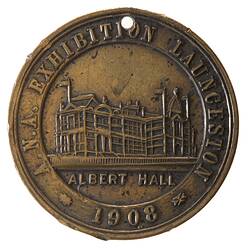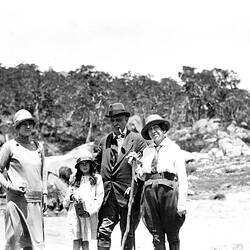Summary
During World War I, the date of Australia Day was not formalized. In 1915, during the Gallipoli campaign, 30 July was termed Australia Day, and used to raise funds for the war and celebrate the military action in Gallipoli. It is likely that this image depicts a parade on the corner of Collins Street & Russell Streets on 30 July 1915. The soldiers in the charabanc may have been amongst those who had returned to Australia due to injuries or being otherwise unfit for service.
Meanwhile, the Australian Natives Association had for years been campaigning for 26 January to be celebrated as Australia Day, known then in Victoria as 'Foundation Day'. It was not until 1935 that all Australian states finally agreed on a single date for Australia Day - 26 January.
The Australian Natives' Association was established in Melbourne in 1871 as a non-partisan and non-sectarian friendly society for Australian-born, white men seeking to shape Australia's nationhood and identity. The ANA was a strong advocate for Federation and became an advocate for White Australia. It was a staunch supporter of trade protection and immigration restriction, and Prime Minister Alfred Deakin was a member.
Description of Content
Returned soldiers in parade as part of Australia Day celebrations. The soldiers are seated in a charabanc (an open motor coach).
More Information
-
Collection Names
-
Collecting Areas
-
Acquisition Information
Copied from J A Chisholm, 25 Mar 1985
-
Place & Date Depicted
Collins Street & Russell Street, Melbourne, Greater Melbourne, Victoria, Australia, 1915
Originally identified as 'Australia Day', 26 January 1915, this image was probably taken on the date in 1915 that Australia Day was celebrated - 30 July. -
Photographer
-
Other Association (See Comments)
Australian Natives' Association
The Australian Natives Association had for years been campaigning for 26 January to be celebrated as Australia Day, known then in Victoria as 'Foundation Day'. It was not until 1935 that all Australian states finally agreed on a single date for Australia Day - 26 January. This image probably depicts another date for Australia Day - 30 July 1915. -
Format
Negative, 35 mm, Black & White
-
Classification
-
Category
-
Discipline
-
Type of item
-
References
Australia Day web site, accessed 13/9/2012
-
Keywords
Australia Day, Celebrations, Churches, Parades, Soldiers, Wars & Conflicts, World War I, 1914-1918


